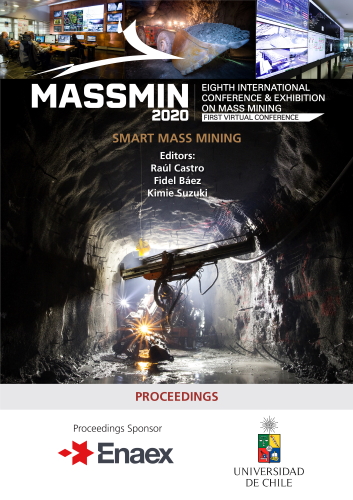Delineation of concealed structures in block caving environments using seismic response to hydoraulic fracturing: A methodology

|
Authors: Tennant, DE; Stonestreet, PG |
This paper is hosted with the kind permission of Lulea University of Technology, International Conference & Exhibition on Mass Mining, 2024.
DOI https://doi.org/10.36487/ACG_repo/2063_89
Cite As:
Tennant, DE & Stonestreet, PG 2020, 'Delineation of concealed structures in block caving environments using seismic response to hydoraulic fracturing: A methodology', in R Castro, F Báez & K Suzuki (eds), MassMin 2020: Proceedings of the Eighth International Conference & Exhibition on Mass Mining, University of Chile, Santiago, pp. 1217-1224, https://doi.org/10.36487/ACG_repo/2063_89
Abstract:
Delineating structures can be problematic in the block caving environment due to a lack of tunnel development. Most mining methods require sub-levels at typically 20-50 m intervals, allowing for closely spaced mapping that can be interpolated with a high degree of confidence. Conversely, block caving mines generally have two effective levels – closely-spaced extraction and undercut levels, and a cave engineering level several hundred metres above. To add further uncertainty, critical infrastructures are usually located in waste rock and not within the orebody or footprint. This can result in speculative interpolations of mapped structures between levels and within waste rock. Recently, hydraulic fracturing of geological structures to reduce associated seismic risk has become industry best-practice. Installation of an accelerometer seismic array can detect smaller (high frequency) seismic events generated from a hydraulic fracturing program, whereas a mine’s typical geophone network is unable to detect these micro-seismic events. Analysis of the seismic data during and after the hydraulic fracturing program can reveal thousands of micro-seismic events, and in special circumstances, these events plot on clearly defined planes in a geometric pattern consistent with the known structural framework. When coupled with focal mechanism data from a robust geophone network, faults and lithological contacts can be accurately delineated. Because most drilling campaigns focus primarily on the orebody, very little information is available regarding structure in the country rock where most of a mine’s critical infrastructure is usually located. Although the intention for the installation of an accelerometer array in a hydraulic fracturing program is to identify the extent and orientation of hydraulic fractures, the identification and delineation of concealed geological structures can also be realized. The seismic response associated with structures due to hydraulic fracturing in a highly stressed rockmass also provides key insights as to which structures may pose a seismic hazard during cave establishment and growth, an extremely valuable input for geotechnical and mine design. A case study from Cadia East Mine in New South Wales, Australia, provides a methodology for structural modelling in highly stressed rockmasses as well as a proactive approach to identify structures which are prone to slip.
References:
Carter, TG, Rogers, SF, Taylor, JJL & Smith, J 2015, ‘Unravelling structural fabric — a necessity for realistic rock mass characterisation for deep mine design’, in Y Potvin (ed.), Proceedings of the International Seminar on Design Methods in Underground Mining, Australian Centre for Geomechanics, Perth, pp. 317-338.
Zepeda A, R 2017, ‘Fault G - Reserva Norte, Pre-conditioning by hydraulic fracturing in El Teniente division, SEG-DGD-GRMD’, Unpublished Presentation, CODELCO (internal), in Spanish.
© Copyright 2025, Australian Centre for Geomechanics (ACG), The University of Western Australia. All rights reserved.
View copyright/legal information
Please direct any queries or error reports to repository-acg@uwa.edu.au
View copyright/legal information
Please direct any queries or error reports to repository-acg@uwa.edu.au
